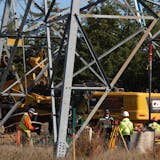Otter Tail Power Co. must exit a large North Dakota coal plant by 2032 — at least as far as its Minnesota customers are concerned, state regulators ruled Thursday during a contentious meeting.
Looming over the Minnesota Public Utilities Commission’s decision were the starkly different energy policies of Minnesota — which is pushing hard on clean energy — and North Dakota, which is focused on preserving its coal industry and a fleet of coal-fired power plants.
At issue: Fergus Falls-based Otter Tail only owns 35% of the power plant, called Coyote Station. So the plant could run at partial capacity after 2031.
Otter Tail’s two largest power generators — Coyote and another in South Dakota — are co-owned by companies beyond the purview of the PUC. About half of the utility’s customers also are in the Dakotas.
Some PUC commissioners made clear Thursday they believe Otter Tail should exit high-cost Coyote Station by 2029. Otter Tail says that’s not feasible given the interests of the plant’s co-owners.
“I just find this to be a massively frustrating conversation,” PUC Commissioner Joe Sullivan said at a meeting Thursday. “I sympathize with Otter Tail, you have two different jurisdictions that look at the world differently. But if [Coyote Station] were in Minnesota, we’d say, ‘Otter Tail, it’s time to pull out.’”
The Coyote Station plant, Sullivan added, is “uneconomic.”
Coyote Station, outside Beulah, N.D., is also a particularly dirty coal plant, emitting far more sulfur dioxide, nitrogen oxide and mercury than any coal plant in Minnesota. It’s depreciable life runs through 2040.


